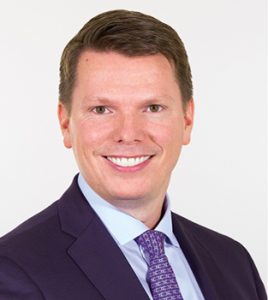
Neil Blundell

Jacob Borbidge
Q: What prompted you to update your capital market assumptions methodology?
Jacob Borbidge: We continually seek to identify and develop new and better ways to model
asset classes and forecast returns and risk. The additional work we began last summer stemmed from our recognition that as technology evolves we are able to access new data sets for additional asset classes, allowing us to begin modeling them with the same precision we bring to more mainstream asset classes. And for multi-asset-class investors, having more data about more asset classes is always welcome.
Q: Has your methodology itself changed?
Borbidge: No. We have always used a fundamental “building-block” approach to forecast returns based on the underlying drivers of asset class performance——that’s not changed and frankly it’s not uncommon. But what we do is distinctive.
For example, we never assume a risk premium for an asset class simply because it is risky. Each asset class has to earn its risk premium based on the underlying fundamental drivers of its return components. And we cover an unusually wide range of asset classes and create assumptions for multiple investment horizons.
Q: Which asset classes have you added to your work—and which new time horizons?
Neil Blundell: Our capital market assumptions now include a range of what we call nondirectional liquid alternatives, such as macro, equity-market-neutral and equity long-short. These sub-asset classes can act as proxies for hedge-fund-like strategies. And we now model a five-year horizon in addition to a 10-year horizon.
“As asset allocators ourselves, we live the same challenges and experiences our clients do. So we’re constantly trying to think of better ways to create multi-asset portfolios.”Q: Were clients pushing for this, or was it an internal decision?
—Jacob Borbidge
Borbidge: It was a little of both. As asset allocators ourselves, we live the same challenges and experiences our clients do. So we’re constantly trying to think of better ways to create multi-asset portfolios. One of the things we and our clients realized was that after 10 years of economic expansion and a bull market in equities there were concerns around the sustainability of that bull market. There was a need to think about other ways to invest capital that might include diversifying away from equities. One way to do that is to look at alternatives, where my team has been investing for over five years now. We help our clients better understand that space by providing risk-and-return forecasts for those asset classes directly. As for adding a five-year forecast, we always envisioned our 10-year forecast as one that would cover a full market cycle. But I think most of our clients would be of the opinion that we’re more likely to be in more of a contractionary environment over the next five years. If so, and if you had to plan for the next quarter cycle or half cycle, you’d want to know what asset class returns and risks might look like over a shorter time period. That’s what drove the thinking on the five-year forecast.
Q: Alternatives aren’t always as transparent as publicly traded equities or fixed income. How do you account for that?
Borbidge: Part of it is being resourceful and creative in finding data sources. There’s also a degree of practitioner experience that helps. For example, our experience has helped us identify linkages between supposedly nondirectional, market-neutral strategies and traditional equities. We understand that even though an equity market-neutral strategy is intended to have a moderate amount of beta relative to traditional asset classes, it’s still investing in equities. We also recognize that there are still inefficiencies in one’s ability to model the risk or the correlation of those asset classes. Because of that, there will be residual exposure to traditional assets in those alternative asset classes which we can model for our clients, and walk them through the implications.
Blundell: That’s actually a critical point. As we come up with our assumptions, we’re always thinking about how we’re modeling risk and the cross-correlations between traditional and alternative assets. Our findings contribute deeply into our convictions on asset allocation.
Q: The fourth quarter of 2018 was very volatile, with the S&P 500 stock index falling nearly 20 percent. How has that impacted your capital market assumptions?
Borbidge: We went from a very low-return market forecast to one that’s a little higher——probably in the median range historically. As far as different asset classes, equities across the board looked more attractive at the end of the year than they did at the middle of the year——a natural outgrowth of a correction that brought valuations down. We haven’t seen much change there yet. In the fixed-income markets, things that had significant amounts of credit exposure probably saw the largest upticks in terms of forward-looking return expectations. You’re getting higher yields now, and paying less for roughly the same amount of growth you expected a few months ago. The next couple of months will be telling to see whether or not that growth story holds up.
Q: But the outlook is generally favorable?
Borbidge: It is. But the challenge is that we had an environment where forward-looking expectations had been coming down continually for a number of years. As a result, valuation spreads had continued to widen, and yield spreads on credit-sensitive assets had continued to contract, for several consecutive years. The market had gotten used to demanding a small price for taking either equity or credit risk. The price has increased but I think we have to be cautious in jumping back into the markets with the understanding that, from a historical context, equities are not overly cheap and credit spreads are not wide. They’re just a little wider than they were a few months ago. To expand on that, it’s very rare to go from a point where credit spreads or equity valuations are at a significant high to a median point and then not cross that median point and become significantly more discounted. It happens, but once the valuation spreads start widening or credit spreads start widening, they usually widen for a substantial amount of time and then cross that median point.
We’re always thinking about how we’re modeling risk and the cross-correlations between traditional and alternatives assets.Q: What’s the solution for investors?
—Neil Blundell
Borbidge: One solution is diversification——something that had not been very essential when all asset classes——especially equities——were on the rise. We saw tremendous benefits to diversification in the fourth quarter last year, and I think diversification will matter more over the coming years than it has over the previous few.
Q: What else are your current capital market assumptions telling you that investors should be thinking about right now?
Borbidge: It is always helpful to contextualize a range of potential outcomes. One way to do that is by looking at different investment horizons for your risk and return forecasts. You always want to look at not just a single return forecast, but a range of potential return expectations and outcomes. You hope things perform well, but you want to know how badly various asset classes could perform if we experience some elevated volatility or some significant discounting in the marketplace.
Q: Anything else investors should know right now?
Blundell: I would add there is real value to using our capital market assumptions collectively rather than in isolation. Here’s what I mean. When we apply our capital market assumptions to our own investing, or think about how clients might use them, we also consider what we or they are trying to solve for. It is growth? Income? More diversification? Once we know that, looking at the forecasted risk and returns for the various asset classes, and the cross-correlations between those asset classes, can really be valuable. If a client is looking for more diversification, for example, we can look at their current portfolio, what we think their expected returns are, and how they perform in stress tests. Then we can determine how we might layer in new asset classes or new customized solutions to their portfolio to achieve their desired outcome. The point is, these assumptions can be used on an individual basis, but they also can be used in tandem to create customized, outcome-oriented asset allocation strategies. And that’s never more valuable than when markets turn volatile.
This article is for US Institutional Investor Use Only.
Content was developed in February 2019. This is for informational purposes only and is not an offer to buy or sell any financial instruments. As with all investments there are associated inherent risks. This should not be considered a recommendation to purchase any investment product. The opinions expressed in this article are those of the authors and are based on current market conditions and are subject to change without notice. These opinions may differ from those of other Invesco investment professionals.
Asset allocation, diversification and low or negative correlation do not guarantee a profit or eliminate
the risk of loss. Alternative products typically hold more non-traditional investments and employ more complex trading strategies. Investors considering alternatives should be aware of their unique characteristics and additional risks from the strategies they use. Forward-looking statements are not guarantees of future results. They involve risks, uncertainties and assumptions. There can be no assurance that actual results will not differ materially from expectations.
Invesco Advisers Inc. is an investment adviser; it provides investment advisory services to individual and institutional clients and does not sell securities. NA2073

